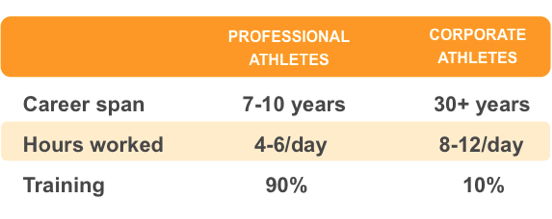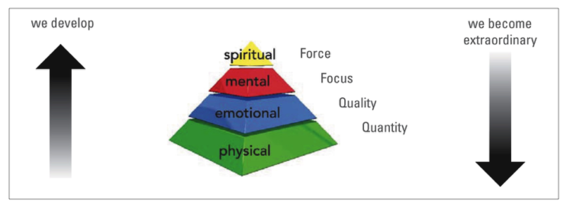
Tom Ward and I recently co-authored a 5-part series called Leadership in the Zone, where we discussed how to develop fully engaged leaders by using the energy management framework developed by the Johnson & Johnson Human Performance Institute. As a result of that series, Dr. Jack Groppel, co-founder of the Human Performance Institute, is joining us for this post.
So grab a pencil because we're going to start with a quiz created by Dr. Groppel. Before you start the quiz, take a look in the mirror and be totally honest with yourself. How many of the following statements apply to your life? Put a checkmark next to those that apply.
- I often feel overwhelmed
- I usually feel that I don't have enough time in the day
- I struggle with being present, or in the moment
- I struggle to prioritize self-care (e.g., exercise, eating well, etc.)
- I have to multitask to perform at a high level
- I have incredibly high pressure with my job
- My work/life balance is not very good
- I have way too many emails and projects to navigate
- I'm tired of being tired
- I often struggle with being fresh and creative in my job
If you checked four or more, fall in line. This is the state of our lives in today's world, and never more so than in business. Add to this the imperative of leaders to lead. Yet, how can we lead effectively if we are checking boxes in the above list? And, how can we lead groups of high performers who describe their lives with these same thoughts?
Humor me for a minute and picture your favorite athlete. In my case it's Mia Hamm, the Olympic champion soccer player. Now, imagine you are about to watch Mia and her teammates vie for the World Championship and only you know the following about her current condition.
- slept only five hours last night, when she normally requires 8
- eaten nothing today
- had an argument with her co-captain only moments ago
- (contrary to team policy) stashed her smart phone in her sidelines gym bag so she can be in touch with her best friend during the game, and
- (to top it all off) has no passion for continuing to play competitive soccer
I know; this exercise is nonsensical. Mia would never show up that way because as a highly trained professional she knows key moments require her very best. But how many business leaders do you know who have "taken the field" under such circumstances? Why is that? Jack shares his ideas with us about the fundamental problem.
What's the fundamental problem?
- Under intense pressure constantly
- Judged by their numbers
- Held brutally accountable
- Required to be laser focused moment-to-moment
- Pushed to do more every year
Business leaders, known as 'corporate athletes®', face similar conditions. Though when we compare professional athletes to corporate athletes along three basic dimensions - career span, hours worked per day, and time devoted to training - we see some stark differences.
 *Time spent training/practicing vs competing/performing
*Time spent training/practicing vs competing/performing
© Human Performance Institute, a Division of Wellness & Prevention, Inc., a Johnson & Johnson Company
Corporate athletes® work much longer on a daily basis and over the course of their careers than professional athletes, yet they devote relatively little time to training. Plus, they don't get an off-season to recover. So how can corporate athletes ever expect to succeed?
Corporate Athlete® Training
Like our fictitious Mia above, many business leaders succumb to performance-diminishing behaviors. Below, Jack shares his insights about the nature of the challenges facing leaders today, and the framework he and his colleagues use to help them learn and train to overcome them.
The HPI Corporate Athlete® model is based on 30 years of research working with elite performers, including Olympic Gold medalists, and built on the sciences of nutrition, exercise physiology, and performance psychology. About twenty years ago, we realized that what we were doing with athletes was not specific to sport. It was universal. The strategies used to improve athletic performance could be applied to any arena. So, we began working with the military, medical doctors, pilots, and finally business leaders, including Fortune 100 CEOs and their organizations.
Participants in the Corporate Athlete® course learn to train like elite athletes - physically, emotionally, mentally, and spiritually - to better manage and expand their energy levels to help them consistently perform at the highest levels.
Human energy is our most critical resource. Without it, where are we? One only has to look at how fatigued we are, as well as the data on how disengaged we are, to understand the truth in these statements. In today's 24/7 world, the constant pressure to perform means organizations are asking more of their employees than ever before. The demands on employees' energy inevitably exceeds capacity, resulting in sub-optimal performance, lower productivity, and disengagement. With proper training, though, this need not be our fate.
The Human Performance Institute uses a multidimensional model of high performance that helps leaders and their organizations learn to meet the ever-increasing demands in their lives, without sacrificing their health and happiness. The model is a Performance Pyramid.
At the top of pyramid is the purpose, or mission, we strive to achieve in our lives (not necessarily just our career). In this "spiritual" dimension, we help leaders understand, build, and grow character. Here leaders learn to lead their lives from "the top-down" and coach their employees to be mission-driven (as opposed to just working hard) in all they do.
The next level down in the pyramid is the mental dimension. Leaders are taught how to be laser focused in how they work, as opposed to being scattered in their efforts (e.g., by multitasking, etc.). Time management alone only takes them from being physically absent to physically present. Only through the management of energy can they become fully engaged and productive.
As we continue down the pyramid, we enter the emotional dimension. For peak performance, leaders are taught how to access what we call opportunistic emotions (e.g., positive, challenged, glass half full, etc.) versus survival emotions (e.g., negative, pessimistic, glass half empty, etc.). This is how to become more emotionally resilient.
The final dimension and the Performance Pyramid's foundation is the physical dimension. Physical movement throughout the day has a tremendous impact on peak performance and leadership. It is important to recognize that physical fitness increases one's energy capacity, nutrition fuels the brain with glucose, and sleep is the key to recovery.
Leadership, both personal and professional, is an energy game. With abundant energy in each of the four dimensions outlined above, our odds for mission success go way up. Just like professional athletes, though, business leaders need to train on purpose properly and regularly to achieve the results they're after.
Today's business challenges are tremendous. What's more, they are ever-increasing. As we've learned from Dr. Jack Groppel above, effectively responding to today's leadership challenges demands a strategic approach - an approach rooted in managing our most precious human resource, human energy. By building The Leader's Edge, it's possible for business leaders not only to address their challenges but also to thrive.
In coming posts, my co-authors and I will get very personal about the challenges we have faced, review how we've used the framework outlined by Jack to address them, and discuss our plans to continue to use the framework as storms and challenges arise. Honing The Leader's Edge isn't easy. But armed with a proven framework and the right strategy, discipline, and conviction of purpose, even the most difficult challenges can be addressed and overcome. We look forward to continuing the journey with you.

